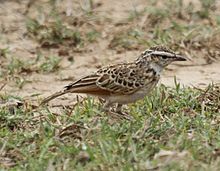Fox lark
| Fox lark | ||||||||||||
|---|---|---|---|---|---|---|---|---|---|---|---|---|

Fox Lark, Ethiopia |
||||||||||||
| Systematics | ||||||||||||
|
||||||||||||
| Scientific name | ||||||||||||
| Calendulauda alopex | ||||||||||||
| ( Sharpe , 1890) |
The fox lark ( Calendulauda alopex ) is a small species of the family of larks. It is about 10 to 20 percent smaller than a skylark and has a stronger bill. The distribution area of the fox lark is in eastern Africa. There are two subspecies. The fox lark has long been classified as a species of the genus Mirafra . Due to its genetic data, however, it is now placed in the genus Calendulauda .
The IUCN classifies the fox lark as not endangered ( least concern ).
features
The fox lark reaches a body length of about 14 to 16 centimeters and weighs about 23 grams. There is no gender dimorphism.
In the nominate form , on the upper side of the body, all feathers on the crown, neck, back neck, coat and back are reddish with hardly any darker feathers centers. As a result, the fox lark has a barely or only slightly striped upper side of the body. The whitish stripe above the eyes is very pronounced and contrasts strikingly with the brown ear covers. The chin, throat and chest are white. The breast is often reddish and speckled and speckled on the sides with reddish brown. The rest of the underside of the body is white. In the subspecies Calendulauda alopex intercedens , the upper side of the body is significantly more variable in color. It ranges from a dark, sand-colored brown to a reddish brown. The middle of the feathers are significantly darker, so that the upper side of the body looks strongly striped. The chest is yellow-brown with a striking dark-brown stripe. The rest of the underside of the body is yellowish white. This subspecies also has a striking light yellow-brown over-eye stripe.
Due to the different plumage colors, the Handbook of the Birds of the World considers it possible that Calendulauda alopex intercedens must be regarded as a separate species.
Distribution area of the subspecies
There are two subspecies:
- C. a. intercedens - ( Reichenow , 1895) Originally described as a separate species in the genus Mirafra , this subspecies occurs from eastern and southern Ethiopia and western Somalia to the east of Uganda, Kenya and the northeast of Tanzania. The subspecies is among other things in the Serengeti before.
- C. a. alopex - ( Sharpe , 1890) : Found from south-east Ethiopia to north-west Somalia.
Fox larks are resident birds and occur almost exclusively in areas with sandy soils. The nominate form inhabits open grassland with isolated bushes.
Way of life
The fox lark lives solitary or in pairs. The diet consists of insects and seeds that are picked from the ground.
Like all larks, the fox lark is a ground breeder. The breeding season falls from March to June.
literature
- Rudolf Pätzold : The larks of the world . Westarp Sciences, Magdeburg 1994, ISBN 3-89432-422-8 .
- Rudolf Pätzold: Compendium of Larks. All the larks on earth. Jan-Schimkat-Medienpublikation, Dresden 2003, ISBN 3-00-011219-7 .
Web links
- Song of the Fox Lark on Xeno-Canto
- Calendulauda alopex in the Red List of Threatened Species of the IUCN 2016. Posted by: BirdLife International, 2016. Accessed March 9, 2017th
Single receipts
- ↑ a b c d e Handbook of the Birds of the World zur Fuchslerche , accessed on March 9, 2017
- ↑ Calendulauda alopex in the Red List of Threatened Species of the IUCN 2016. Posted by: BirdLife International, 2016. Accessed March 9, 2017th
- ^ Pätzold: Compendium of Larks . P. 94.
- ^ IOC World Bird List 6.4 . In: IOC World Bird List Datasets . September. doi : 10.14344 / ioc.ml.6.4 .

